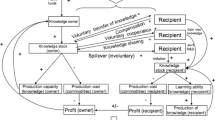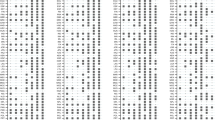Abstract
Regional growth models often emphasize the importance of research and development activities leading to technological progress. The role of knowledge production and spatiotemporal spillover effects is investigated using a space-time panel data set covering 49 US states over the period 1994–2005. The aim is to test for the existence of regional knowledge spillovers in the context of a space-time dynamic suggested by the knowledge production function. A space-time specification is set forth that can be applied to panel data models that include random effects. We compare alternative models that have been proposed in the panel data literature to provide a better understanding of how new ideas diffuse across space and time. The results indicate that the space-time panel data set is consistent with the presence of strong spatiotemporal regional spillovers of knowledge. The empirical findings are interpreted in light of the existing theoretical and empirical literature on endogenous growth.




Similar content being viewed by others
Notes
We treat the District of Columbia as a state and use the 48 contiguous states, excluding Alaska and Hawaii.
We will use the term neighboring regions in a broad sense to reflect regions that exhibit both geographic as well as technological proximity throughout this paper. Details are provided regarding the empirical approach to mixing geographic and technological proximity later.
A set of exploratory and spatial modeling functionality with Matlab has been developed by Liu and LeSage (2010).
We do not use metropolitan areas because of the potential conflict with cities spread over different states.
Yearly data on patenting by geographic region, breakout by technology class over the period 1969–2007 are electronically published on the USPTO web site at http://www.uspto.gov/web/offices/ac/ido/oeip/taf/clsstca/stc_cl_gd.htm.
The spatial weight matrix is row normalized so that the maximum eigenvalue ψmax is equal to one.
The average growth rate of patenting activities per capita over the last four decades (1970–2006) across the 49 states is equal to 0.022.
It might be plausible to argue that inventions have become more accessible in more recent years covered by our panel because of improved telecommunications and Internet data access.
Note that differences in the numerical values of the two criteria are explained by the fact that the marginal likelihoods are based on posterior ordinates that are smaller (in absolute value) than the prior ordinates.
As explained in Hsiao (2003), the stationary assumption can be relaxed for the first period if we assume the process began close to the observed initial period.
Data available at the U.S. Department of Commerce, U.S. Patent and Trademark Office. Patent Counts By Country/State And Year: Utility Patents: January 1, 1963–December 31, 2006
References
Anselin L (1988) Spatial econometrics. Methods and models. Kluwer, Boston
Autant-Bernard C (2001) Science and knowledge flows: evidence from the French case. Res Policy 30(7):1069–1078
Baltagi BH, Song SH, Jung BC, Koh W (2007) Testing for serial correlation, spatial autocorrelation and random effects using panel data. J Economet 140(1):5–51
Banerjee S, Carlin BP, Gelfand AE (2004) Hierarchical modeling and analysis for spatial data. Chapman and Hall/CRC Press, Boca Raton
Bhargava A, Sargan JD (1983) Estimating dynamic random effects models from panel data covering short time periods. Econometrica 51(6):1635–1659
Bottazzi L, Peri G (2007) The international dynamics of R&D and innovation in the long run and in the short run. Econ J 117(518):486–511
Branstetter L (2001) Are knowledge spillovers international or intranational in scope? Microeconometric evidence from the US and Japan. J Int Econ 53(1):53–79
Caballero R, Jaffe A (1993) How high are the giants’ shoulders: an empirical assessment of knowledge spillovers and creative destruction in a model of economic growth. In: Blanchard O, Fischer S (eds) NBER macroeconomics annual. MIT Press, Cambridge, pp 15–86
Chib S, Jeliazkov I (2001) Marginal likelihood from the Metropolis-Hastings output. J Am Stat Assoc 96(453):270–281
Coe D, Helpman E (1995) International R&D spillovers. Eur Econ Rev 39(5):859–887
Devereux MP, Lockwood B, Redoano M (2007) Horizontal and vertical indirect tax competition: theory and some evidence from the USA. J Public Econ 91(3):451–479
Eaton J, Kortum S (1999) International technology diffusion: theory and measurement. Int Econ Rev 40(3):537–570
Elhorst P (2004) Serial and spatial error dependence in space-time models. In: Getis A, Mur J, Zoller HG (eds) Spatial econometrics and spatial statistics. Palgrave-Macmillan, London, pp 176–193
Elhorst P (2005) Unconditional maximum likelihood estimation of linear and log-linear dynamic models for spatial panels. Geograph Anal 37(1):85–106
Elhorst P (2010) Applied spatial econometrics: raising the bar. Spatial Econ Anal 5(1):9–28
Elhorst P (2010) Dynamic panels with endogenous interaction effects when T is small. Reg Sci Urban Econ 40(5):272–282
Ertur C, Koch W (2007) The role of human capital and technological interdependence in growth and convergence processes: international evidence. J Appl Economet 22(6):1033–1062
Fischer MM (2010) A spatial Mankiw-Romer-Weil model: theory and evidence. Ann Reg Sci. (http://dx.doi.org/10.1007/s00168-010-0384-6)
Fischer MM, Scherngell T, Reismann M (2009) Knowledge spillovers and total factor productivity. Evidence using a spatial panel data model. Geograph Anal 41(2):204–220
Hsiao C (2003) Analysis of panel data. Cambridge University Press, Cambridge
Jaffe AB (1986) Technological opportunity and spillovers of R&D: evidence from firms’ patents, profits, and market value. Am Econ Rev 76(5):984–1001
Jaffe AB, Trajtenberg M, Henderson R (1993) Geographic localization of knowledge spillovers as evidenced by patent citations. Q J Econ 108(3):577–98
Jaffe AB, Trajtenberg M (2002) Patents, citations, and innovations: a window on the knowledge economy. MIT Press, Cambridge
Jones CI (1995) R&D-based models of economics growth. J Polit Econ 103(4):759–582
Jones CI (2002) Sources of U.S. economic growth in a world of ideas. Am Econ Rev 92(1):220–239
Kass R, Raftery A (1995) Bayes factors. J Am Stat Assoc 90(430):773–795
Keller W (2002) Geographic localization of international technology diffusion. Am Econ Rev 92:120–142
LeSage JP, Fischer MM (2011) Estimates and inferences of knowledge capital impacts on regional total factor productivity. Int Reg Sci Rev 34 (forthcoming)
LeSage JP, Pace RK (2009) An introduction to spatial econometrics. CRC Press, Boca Raton
Liu X, LeSage JP (2010) Arc_Mat: a Matlab-base spatial data analysis toolbox. J Geograph Syst 12(1):69–87
Pace RK, LeSage JP (2009) A sampling approach to estimate the log determinant used in spatial likelihood problems. J Geograph Syst 11(3):209–225
Pace RK, LeSage JP (2009) Omitted variables biases of OLS and spatial lag models. In: Paez A, Builing R N, Le Gallo J, Dall’erba S (eds) Progress in spatial analysis. Springer, Berlin, pp 17–28
Mancusi ML (2008) International spillovers and absorptive capacity: a cross-country, cross-sector analysis based on patents and citations. J Int Econ 76(2):155–165
Parent O, LeSage JP (2008) Using the variance structure of the conditional autoregressive spatial specification to model knowledge spillovers. J Appl Economet 23(2):235–256
Parent O, LeSage JP (2009) Spatial dynamic panel data models with random effects. Working paper
Parent O, LeSage JP (2011) A space-time filter for panel data models containing random effects. Comput Stat Data Anal 55(1):475–490
Parent O, LeSage JP (2011b) Determinants of knowledge production and their effects on regional economic growth. J Reg Sci (forthcoming)
Peri G (2005) Determinants of knowledge flows and their effects on innovation. Rev Econ Stat 87(2):308–22
Romer PM (1990) Endogenous technological change. J Polit Econ 98(5):71–102
Spiegelhalter DJ, Best NG, Carlin BP, van der Linde A (2002) Bayesian measures of model complexity and fit. J R Stat Soc Ser B 64(4):1–34
Stephan P (1996) The economics of science. J Econ Lit 34(3):1199–1235
Su L, Yang Z (2007) QML estimation of dynamic panel data models with spatial errors. Singapore Management University manuscript
Yu J, de Jong R, Lee LF (2008) Quasi-maximum likelihood estimators for spatial dynamic panel data with fixed effects when both n and T are large. J Economet 146(1):118–134
Acknowledgment
I would like to thank Randall W. Jackson, James P. LeSage, Claude Lopez and Jeffrey Mills for their valuable comments. The author wants to thank William H. Miernyk, the Regional Research Institute at West Virginia University and the Taft Research Center at the University of Cincinnati for providing generous research support.
Author information
Authors and Affiliations
Corresponding author
Appendices
Appendix 1: Endogenous specification
The extension exploits spatial dependence between each observation/region. In the empirical application, the first cross-section is treated as unconditional (endogenous) and it is assumed that the sample \(t=1, \ldots, T\) observations and presample values (those prior to time 1) were generated by the same process.
To motivate the spatial extension of the method, Bhargava and Sargan (1983) note that recursive substitution of the spatial dynamic panel data model described by Eq. 8 leads to an expression for the observation y t equal to:
where A = ϕI N + θW.
The stationarity assumption |A| < 1 is equivalent to |ϕ| + |θ| < 1 if the spatial weight matrix is row normalized so the maximum eigenvalue equals one. This implies the first right-hand side variable approaches zero as s approaches infinity. Bhargava and Sargan (1983) note that since \(\sum_{s=0}^{+\infty} x_{-s-1}\) is not observed, the covariance structure for this observation and other time periods, var − cov(y 0) is undetermined. We follow their suggestion and rely on an optimal predictor for \(\tilde{y}_0\) under the stationary assumption:
where π0 is an intercept coefficient, \(x^{\ast}=(x_0,\ldots,x_{T-1})\) is the N × kT matrix of explanatory variables, \(\pi = (\pi_1',\ldots,\pi_{T}')'\) is a kT vector of unknown parameters and \(\xi \sim N(0,\sigma_{\xi}^{2}I_N). \) Footnote 10 The initial observation y 0 can be approximated using:
The error term ξ0 is the sum of three components: the prediction error ξ for \(\tilde{y}_{0}, \) the individual effects μ, and the cumulative shocks before time zero. Thus,
and the predictor of \(\tilde{y}_0\) is defined as in Eq. 20.
The log likelihood for this model involves the N (T + 1) × N (T + 1) variance-covariance of \(u = (\xi_0,\eta')', \) which we denote \( \Upomega^{\ast}:\)
where \( w_{21}=w_{12}'\) and \(\Upomega\) is defined in Eq. 9.
The log likelihood for this endogenous treatment of the initial period observations has the following form:
which differs from Eq. 10 due to treatment of the initial conditions. Therefore, an incorrect specification choice regarding the first cross-section will yield estimates that are not asymptotically correct (see Hsiao 2003).
Appendix 2: Data
The dependent variable corresponds to the number of U.S. patents granted by the U.S. Patent and Trademark Office during the period 1994–2005. Footnote 11 We assume that ideas production in a given year is reflected in research activities undertaken previously. We calculate the stock of knowledge for each year using a three-year average (A i,t = (Pat i,t + Pat i,t−1 + Pat i,t−2)/3), where Pat i,t represents the number of patent applications filed with the US patent office by inventors living in region i during year t. This captures the time it takes for innovation to materialize through the registration of a patent. Even though less accurate, this method is often used when only data on patents granted are available (see Autant-Bernard 2001; Parent and LeSage 2011b). Note that in case of multi-inventor teams, the first-named inventor is used to determine the location of innovative activities. This neglects the region cooperative activities. A complete analysis of the accumulation process of new ideas using citations and cross-region inventor teams can be found in Fischer et al. (2009).
National Patterns of R&D Resources can be downloaded from the National Science Foundation Website. They describe and analyze patterns of research and development (R&D) in the United States every year since 1994. The vast majority of scientists working in the laboratory are postdocs and doctoral students (Stephan 1996). Data related to the number of doctorates awarded are derived from the fall 2005 National Science Foundation-National Institutes and the Survey of Earned Doctorates. This survey is designed to obtain characteristics of doctorate recipients from U.S. institutions. The measure of output is Gross State Product (GSP) in manufacturing from the BEA Website.
Rights and permissions
About this article
Cite this article
Parent, O. A space-time analysis of knowledge production. J Geogr Syst 14, 49–73 (2012). https://doi.org/10.1007/s10109-011-0151-y
Received:
Accepted:
Published:
Issue Date:
DOI: https://doi.org/10.1007/s10109-011-0151-y




